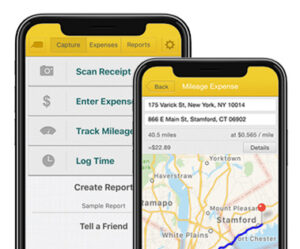Which is Better, Standard Mileage Rate vs Actual Car Expenses Method?
Table of Contents
Do you want to know how to write off business vehicle use? Learn how to vehicle tax deductions.

There are two methods to calculate expenses for business use car tax deductions:
- Standard Mileage Method
- Actual Expense Method
It is up to the taxpayer to decide which one is best. Which method do you choose? This post provides an overview of both methods so that you can find the one that is best for you.
New Change Starting in 2018 Tax Year as per Publication 463:
Employees can no longer claim the cost of using their car as unreimbursed employee travel expenses as a miscellaneous itemized deduction. Therefore, you can no longer deduct unreimbursed business use expenses of your car if you are an employee that used your car for work. This is because of the suspension of miscellaneous itemized deductions that are subject to the 2% floor detailed in section 67 of publication 463. The suspension applies to tax years beginning after Dec 2017. Deductions for expenses that are deductible in determining adjusted gross income are not suspended. This applies to the employee whether they use the standard rate tax deduction method of the actual car expense method. However, this does not apply to freelancers and independents.
The Standard Mileage Rate Method
The standard mileage rate is a method of deducting an IRS-established per mile tax-deductible dollar amount. The established per mile amount is only deductible for mileage driven for business purposes. Further, this method can only be used by the owner or lessor of the vehicle. For 2019, the standard mileage rate method is $0.58 per mile.
For an up-to-date list of the standard mileage rate deductions bookmark our post, IRS Standard Mileage Rate Tax Deductions.
To use this method the taxpayer must keep a record or log of the miles traveled for business. This includes information such as the destination and business purpose (IRS Publication 463, Ch 5, Recordkeeping). In addition, the taxpayer must document proof of ownership of the vehicle or a lease. Further, this information is added to the individuals’ tax returns at the end of the year using IRS Form 2106. Also, business-related parking and tolls expenses are
The Standard Mileage Rate cannot be used if the taxpayer …
- Uses the car for hire (such as a taxi)
- Uses five or more cars at the same time (as in a fleet operation)
- Claims depreciation or a section 179 deduction (Publication 463, Chapter 4)
- If a rural mail carrier receives a qualified reimbursement (Publication 463, Chapter 4).
The r
- the miles you drove for business (ie your mileage)
- the places you drove for business
- the business purpose of your trip
- the date of your trip
What qualifies for IRS mileage reimbursement?
To qualify for IRS mileage reimbursement you need to drive for business and record the miles you drove for business as specified by the IRS under the Standard Mileage Rate Expense method.
Falcon Expenses is a mileage expense tracker app and an expense tracker app. Falcon Expenses has an accurate GPS mileage tracker for tracking deductible mileage expenses. Falcon also has the capability to keep an odometer log. All mileage logs can be exported in an IRS-compliant mileage report. Falcon Expenses offers a variety of mileage expense tracking features that are excellent for meeting the IRS mileage log requirements. Please review the posts below, for more information about Falcon Expenses and these features.
Do you drive more than one car for work?
Are you a delivery driver that needs to manage multiple employers as a 1099 contractor?
Learn how to organize 1099 expenses by employer, and an easy way to track and organize vehicle expenses.
The Actual Car Expense Method
The actual car expense method allows taxpayers to deduct the following vehicle and vehicle-related expenses:
- Depreciation
- Lease payments
- Registration fees
- Licenses
- Gas
- Insurance
- Repairs
- Oil
- Garage rent
- Tires
- Tolls
- Parking fees
If the business use of the car is less than 100%, expenses must be proportionally allocated between business and personal use. For example, say you drive your car 20,000 miles in one year–10,000 for business and 10,000 for personal. In this case, the taxpayer can only deduct 50% of the vehicle’s expenses from their tax return. Therefore, in the cases of mixed personal and business use of the car, it is recommended that the taxpayer keep a log of the miles traveled and distinguish the business from personal travel. This will facilitate ease in the determination and calculation of the percentage of the vehicle used for business purposes. In addition, the taxpayer should keep receipts and invoices of vehicle expenses. Taxpayers that use the Actual Car Expense method can use IRS form 2106-EZ, Unreimbursed Employee Business Expenses, to claim these expenses on their tax return. Download this form, here.
Whether you should use the standard mileage rate depends on your vehicle and the amount that you drive your vehicle for work. With strong record-keeping calculating the deductions for both methods can help the taxpayer determine which method will maximize their tax return. Both methods require the taxpayer to keep a mileage log.
Sources:
- IRS Publication 463, Chapter 4, Transportation, Standard Mileage Rate
- Car and Truck Expense Deduction Reminders
- IRS Publication 463, Ch 4, Transportation, Actual Car Expenses
- IRS tax return form for Standard Mileage Rate deductions and other employee business expenses: Form 2106
- The IRS Standard Mileage Rate Deduction Amounts
- Unreimbursed Employee Business Expenses Form 2106-EZ
Common Questions
Are parking and toll expenses tax deductible?
Yes. Parking and tolls are tax-deductible expenses under the standard mileage rate method.
What form do I need to fill out for deduction mileage expenses?
To deduct mileage expenses you need to fill out Form 2106 and attach it to your tax return.
Conclusion
Whether you choose the standard mileage rate vs the actual car expense method depends on your preferences and vehicle expenses. After reading this article, we are certain it is clear that each method has its pros and cons. With that said, you are now equipped to make the best decision.
About Falcon Expenses
Falcon Expenses is a top-rated mobile app for self-employed and small businesses to track expenses and tax deductions. Falcon customers record $6,600, on average, in annual tax deductions. Get started today. The longer you wait the more tax deductions you miss out on.
Automatically track mileage expenses and expenses, keep an odometer log, receipt vault and log billable hours. Quickly organize expenses by time period, project, or client and easily prepare reports to email to anyone in PDF or spreadsheet formats, all from your phone. Use for keeping track of tax deductions, reimbursements, taxes, record keeping, and more. Falcon Expenses is great for delivery drivers, self-employed, freelancers, couries, realtors, business travelers, truckers, and more.
Was this article helpful?
We are a team of writers and contributors with a passion for creating valuable content for small business owners, self-employed, entrepreneurs, and more.
Feel free to reach out to use as support@falconexpenses.com





